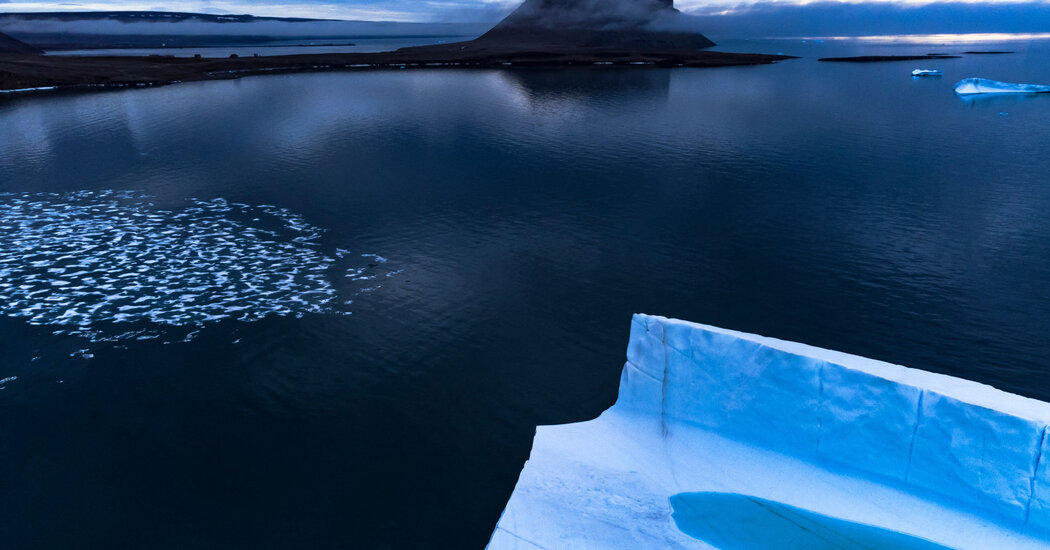The rapid warming of the Arctic, a definitive sign of climate change, is occurring even faster than previously described, researchers in Finland said Thursday.
Over the past four decades the region has been heating up four times faster than the global average, not the commonly reported two to three times. And some parts of the region, notably the Barents Sea north of Norway and Russia, are warming up to seven times faster, they said.
The result is faster melting of the Greenland ice sheet, which leads to greater sea-level rise. But it also affects atmospheric circulation in North America and elsewhere, with impacts on weather like extreme rainfall and heat waves, although some of the impacts are a subject of debate among scientists.
While scientists have long known that average temperatures in the Arctic are increasing faster than the rest of the planet, the rate has been a source of confusion. Studies and news accounts have estimated it is two to three times faster than the global average.
Mika Rantanen, a researcher at the Finnish Meteorological Institute in Helsinki, said he and his colleagues decided to look at the issue in the summer of 2020, when intense heat waves in the Siberian Arctic drew a lot of attention.
Understand the Latest News on Climate Change
Understand the Latest News on Climate Change
In the Amazon. The United Nations Development Program has worked with energy companies in the region to quash opposition and keep oil flowing, internal documents and interviews with several officials show. The collaboration is one example of how the organization will at times partner with polluters that work against the interests of the communities the agency is supposed to help.
“We were frustrated by the fact that there’s this saying that the Arctic is warming twice as fast as the globe,” Dr. Rantanen said. “But when you look at the data, you can easily see that it is close to four.”
The new findings are bolstered by those of another recent study, led by scientists at Los Alamos National Laboratory, which found similar rates of warming, although over a different time span.
The Arctic has long been an important indicator of climate change, and reducing warming there by cutting emissions of greenhouse gases will require international cooperation to prevent the most catastrophic effects. Reduction of emissions from the United States, historically the largest emitter and now second behind China, is a focus of the Biden administration’s climate package that is expected to soon gain Congressional approval.
The Arctic is heating more rapidly in large part because of a feedback loop in which warming melts sea ice in the region, which exposes more of the Arctic Ocean to sunlight and leads to more warming, which in turn leads to even more melting and warming. The result of this and other oceanic and atmospheric processes is called Arctic amplification.
How the rate of warming in the Arctic is described compared with the global average is related in part to the time period that is analyzed and how the region is defined.
The new analysis, published in the journal Communications Earth and Environment, begins with data from 1979, when accurate temperature estimates from satellite sensors first became available. The researchers also defined the Arctic as the area north of the Arctic Circle, above about 66 degrees latitude.
Thomas Ballinger, a researcher at the University of Alaska Fairbanks, said how the region is defined “is a very, very relevant conversation for understanding Arctic change.” A bigger Arctic would include more land, reducing the impact of the ice-ocean feedback on average temperatures.
Dr. Ballinger, who was not involved in either study, is an author of the annual Arctic Report Card prepared for the National Oceanic and Atmospheric Administration. He said some of the findings in the Finnish study were especially interesting, including those showing very high rates of warming in the late 1980s and 1990s. “That really was when Arctic amplification rates were the strongest,” he said.
The earlier study, published last month in Geophysical Research Letters, looked at data from 1960 onward and defined a larger Arctic, north of 65 degrees latitude, which includes more land. It found that the rate of warming reached four times the global average starting about 20 years ago.
Unlike the Finnish study, it found that there were two decade-long periods, from the mid-1980s to the mid-1990s, and in the 2000s, with large jumps in warming in the region. “It doesn’t change continuously, it changes in steps,” said Manvendra K. Dubey, an atmospheric scientist at Los Alamos and one of the study’s authors.
Dr. Dubey said the step-like increases suggest that in addition to the effects of increased greenhouse gas emissions from human activity, natural climate variability, may also play a role in the rapid warming in the region.
Dr. Rantanen said his group’s results also point to natural variability as having some influence on the rate of warming, perhaps some long-term changes in ocean or atmospheric circulation.
But clearly the interaction between water temperature and ice is most important, he said, especially in areas like the Barents Sea where the warming rate is even higher.
“The warming trends are quite strongly coupled with the decline of sea ice,” he said. “They’re most highest over those areas where the sea ice has been declining the most. That’s the primary reason.”
